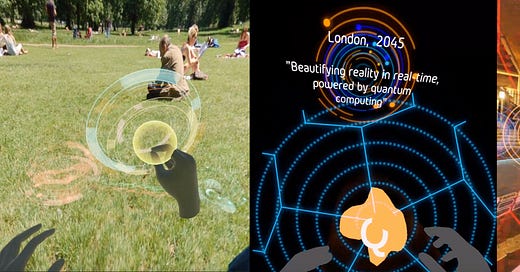Will our vision of AR in the 2020s be a downgrade in 2045?
And where does quantum computing fit in all of this?
First of all, I am trying to find consistency with the newsletter and make it a Sunday routine that arrives at your inbox Monday morning at the latest. Here we go!
At present, we invested in the XR space tend to imagine augmented reality as a next-generation paradigm for how we will interact with information, objects, and other people.

What if, in 25 years, that paradigm would already be considered a clunky, less-than-premium option to conduct one’s business in a world that is moving from digital to quantum?
This was one of the ideas that emerged from spending a few nights last week in a Quantum Futures workshop, organised by The School of Critical Design. Us participants were presented with a scenario about the world in 2045. Several pandemics had run their course, as had major ecological catastrophes, but also innovations in vaccine production and garden cities had flourished. We were tasked to create a product or a service concept that would take advantage of quantum computing.
What is quantum computing?
Quantum computing promises increased capabilities to compute and predict phenomena. IBM wrote in a press release in 2015:
A universal quantum computer uses quantum mechanics to process massive amounts of data and perform computations in powerful new ways not possible with today’s conventional computers. This type of leap forward in computing could one day shorten the time to discovery for life-saving cancer drugs to a fraction of what it is today; unlock new facets of artificial intelligence by vastly accelerating machine learning; or safeguard cloud computing systems to be impregnable from cyber-attack.
In my workshop team, we discussed several themes under the heading of smart cities in the 2045 scenario where quantum computers are a commercial reality. How would quantum applications relate e.g. to news, personal data, and personal health in cities? What would be the interfaces city dwellers would use to access services - and who would have access and who wouldn’t?
Mocking up AR scenes using VR
For my part, I concentrated on trying to visualise some of these broad themes. My approach was to find panoramic images, put them into VR and then add 3D assets and some simple interactivity, to create an impression of augmented reality use cases. A couple of late nights did not get me quite as far as I would have wanted, and the video below remains quite abstract - but that is also kind of the point. The video is also slightly out of context, because the scenes tied into the context, including personas, descriptions of technology, and city settings my fellow team members created.
Quantum-powered services in 2045: 5 themes
Nevertheless, the video is an attempt to foster thinking around the access to such services, their business models, and design languages around spatial and quantum computing. I’ll summarise a few themes explored here:
Quantum as a design form
In my understanding, classical mechanics is characterised by linearity in that it is about positions and velocities, and therefore visual metaphors around the topic veer towards lines and vectors. Respectively, quantum mechanics centre around the form of a wave. How, then, would a user interface to a “quantum-powered” service differ from a “classic” one? Should the design reflect this difference?
Interfaces that align with the underlying computing paradigm
As an example of what the above might mean, in the video, the sunny park scenario tries to convey a UI design paradigm with round, pulsating shapes and no text, whereas at the end we arrive at the dystopia, blackmirroresque scene where the UI form language is more rectangular, garish, and intrusive than in the “utopian” one. Both scenarios presume a contact lens-based AR technology in place, with gestural and voice inputs.
No interfaces as premium
The underlying idea here is that the dystopic scene is closer to what we often imagine things going towards (Minority Report being the main culprit), while the former represents an idea that if one is wealthy enough to have access to the quantum-powered services (which, e.g., could provide much more accurate information, let’s say about the weather, stock exchange, traffic, etc), then that benefit also grants those “haves” with more satisfying and elegant user experience.
2020s AR as a downgrade
In contrast, if you imagine the last bit in the video from a homeless person’s point of view - a “have-not” view - then a person in that situation in 2045 in a city might have access but that access is to the previous generation and paradigm, both in terms of the accuracy and breadth of information (not powered by quantum) but also in terms of the user experience. AR as we currently tend to imagine it as a definite downgrade, a pariah experience.
Quantum business models and unintended divides
This kind of development might be the result of current discussions around whether big tech companies should be regulated more strictly regarding their business models and/or broken down to avoid monopolies. A hope fuelling these solutions is that e.g. a subscription model instead of a free, advertising-based model would unravel the echo chambers, fake news, and attention economies that current social networks have built their financial success on.
As an unintended consequence from that, e.g. subscription models imposed on these services, might then create other divides, as described above. This is because the companies in the space would still want to try to broaden access as widely as possible (i.e. provide lower-tier subscription with limited features) but also monetise the ones that are willing to dish out more (i.e. premium subscriptions that would return the investments into quantum computing solutions).
Thoughts?
Stay safe,
Aki



